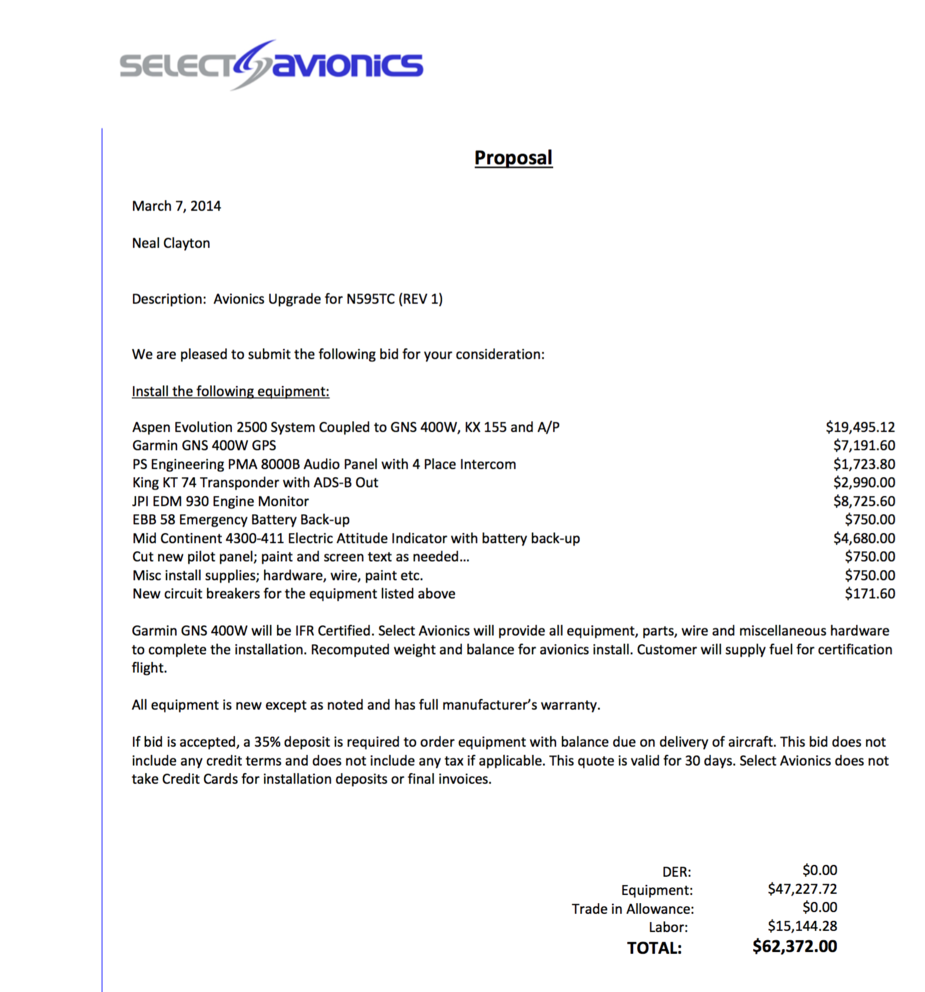If you guys are curious about the United States, here’s my quote from 2 years ago for my airplane.
The total came in very close to this number, with changes along the way of course.
I was coming from the King system that was common in the 1980s/1990s (King slaved HSI system, KLN90 GPS, KX165/KX155, Insight engine monitor, Shadin fuel flow, BFG stormscope, etc).
I wound up selling about 7 thousand dollars worth of used stuff toward that cost.

$8k for the JPI?
That is a lot of labour.
Peter wrote:
$8k for the JPI?That is a lot of labour.
The 8K is for the equipment so it seems. Labour is one big number. The EDM930 takes a long time to install though, with lots of sensors everywhere, renewing the wiring to the float senders, installing all engine probes etc. People tend to underestimate the time involved in such installations.
Just to share my experience. It took 4 man days of labour to put in an EDM 700 with fuel flow into a 4 cylinder Archer.
I agree, these things take time. Archer -181
Yes, those are equipment costs, labor was one all-encompassing estimate.
I also agree that labor for modern engine monitors is high, and people should be leery of installs that are ‘cheaper’ than they should be.
In my case, the entire airplane was re-wired and re-plumbed. At some point it’s not worth the time to separate and mark wires from existing harnesses, but rather just toss them all and start over. The assumption that the factory did a good job of wiring the airplane originally is not always a good one either. On mine they had about 200 feet of extra wire in their main bundle. On the King HSI there was a harness, plugged into an extension, plugged into another harness for no apparent reason (to span a length of 2 feet), for example.
The factory wired my airplane for their own convenience, to make everything fit around the test benches they had set up in the factory. They didn’t care that doing so would make it an electrical nightmare to work on later.
I was told a total time of 20-30 hours to run all new wire and install all new probes for the JPI. More than re-using the existing stuff? Yes, but I’m not scratching my head for 2-3 hours a pop a year later about why TIT suddenly stopped working, either.
Outdated stuff!
I dream about a flying school aeroplane with that much nav equipment in it.
Get rid of the TKM box 2. Replace it with a Garmin 430. Add a king 64 DME and a trig transponder.
Yes that is true; engine monitors can take a day or two to do if you have to drill the exhaust freshly, etc. And a lot longer on some twins; I saw one installation where all the wires had to be run through a tiny 1cm-wide gap between a rib and the wing skin. I didn’t think the job was well done because the wires were unprotected (no grommet etc). It took them about a week.
Looking at a project with King 170Bx2, ADF and Mode C. Likely to junk all except the Mode C.
In terms of meeting 90% of my mission, arguably all I need is an .833khz COM and a RAM holder for the Garmin 196. On the .833 COM choices being Trig, Becker and Garmin GTR225. (£2-3k)
Upgrading to Mode S – on the 90% rule I believe in the UK you only need these in some TMZ (eg Stansted) and in Class A. (£2-4k, £4k might give you a future proofed Garmin which will meet ADSB requirements in the distant/medium future?)
A secondhand IFR GPS either KLN94 or 430 would provide some IR(R) capability, and the 430 also adds .833. A KLN94 might cost £2k and an overhauled 430 £6k, less the cost of the .833, so a delta of £3k.
A GTN650 plus remote GTX33 and a second .833COM plus simple audio panel (£18k?). This is a nice new lite IFR set up. Still trying to figure out what extra kit is needed for traffic and weather to make use of ADSB in capability. No NAV redundancy except for the Garmin 196 on the RAM mount.
On the question of an NDB being required. Most ILS with an NDB, the NDB is required only in the missed approach, and you can advise lack of NDB and request different missed approach instructions – all perfectly legal. The enroute IFR GPS will have a waypoint co located with the NDB (not a user waypoint) which can be used for the hold. Losing the NDB should result in 15 lbs more useful load and KTAS 2 speed gain having ditched the LF/MF antenna.
An S-TEC20 would be useful but have never found an A/P essential. The flight crew flying cheques in Navajos at night never had working autopilots. While CAT 1 single crew require a CAT 1 coupled A/P, am happy with the 800 metre RVR single crew minima over a single channel, no redundancy GA A/P.
Par200a intercom
KLN94
King 87 ADF
King 64 DME
Keep the mode C
Bathman, good find on the PAR200A intercom, with an integrated .833 radio, hadn’t spotted this, very practical.